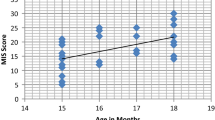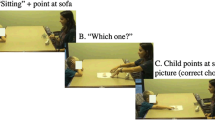Abstract
Children with autism exhibit significant deficits in imitation. Previous research has suggested that object and gesture imitation are independent in autism, and that object imitation may be related to play skills, while gesture imitation may be related to expressive language. However, this finding has not been replicated in the literature. This study examined the concurrent relationship between imitation and language and play in 27 young children with autism. After controlling for developmental age, total imitation was related to child expressive vocabulary. Object imitation had a unique relationship with symbolic play; however, gesture imitation was not uniquely correlated with language. Object and gesture imitation skills were highly correlated, questioning the true independence of these skills in children with autism. Different types of imitation skills in children with autism may be better described as involving a general imitative capacity along with other more specific skills.
Similar content being viewed by others
References
American Psychiatric Association. (2000). Diagnostic and statistical manual of mental disorders, fourth edition, text revision. Washington: American Psychiatric Association.
Bates, E. (1980). Vocal and gestural symbols at 13 months. Merrill-Palmer Quarterly, 26(4), 407–423.
Bates, E., Benigni, L., Bretherton, I., Camaioni, L., & Volterra, V. (1979). The emergence of symbols: Cognition and communication in infancy. New York: Academic.
Bayley, N. (2005). Bayley scales of infant and toddler development (3rd ed.). San Antonio: Psychological Corporation.
Carpenter, M., Nagell, K., & Tomasello, M. (1998). Social cognition, joint attention, and communicative competence from 9 to 15 months of age. Monographs of the Society for Research in Child Development, 63.
Carpenter, M., Pennington, B. F., & Rogers, S. J. (2002). Interrelations among social-cognitive skills in young children with autism. Journal of Autism and Developmental Disorders, 32(2), 91–106.
Charman, T., Baron-Cohen, S., Swettenham, J., Baird, G., Cox, A., & Drew, A. (2000). Testing joint attention, imitation, and play as infancy precursors to language and theory of mind. Cognitive Development, 15(4), 481–498.
Charman, T., Baron-Cohen, S., Swettenham, J., Baird, G., Drew, A., & Cox, A. (2003). Predicting language outcome in infants with autism and pervasive developmental disorder. International Journal of Language & Communication Disorders, 38(3), 265–285.
DeMyer, M. K., Alpern, G. D., Barton, S., DeMyer, W. E., Churchill, D. W., Hingtgen, J. N., et al. (1972). Imitation in autistic, early schizophrenic, and non-psychotic subnormal children. Journal of Autism and Developmental Disorders, 2(3), 264–287.
Dyck, M. J., Piek, J. P., Hay, D., Smith, L., & Hallmayer, J. (2006). Are abilities abnormally interdependent in children with autism? Journal of Clinical Child & Adolescent Psychology, 35(1), 20–33.
Dziuk, M. A., Larson, J. C. G., Apostu, A., Mahone, E. M., Denckla, M. B., & Mostofsky, S. H. (2007). Dyspraxia in autism: association with motor, social, and communicative deficits. Developmental Medicine & Child Neurology, 49(10), 734–739.
Fenson, L., Dale, P. S., Reznick, J. S., Thal, D., Bates, E., Hartung, J. P., et al. (1993). MacArthur communicative development inventories: User's guide and technical manual. San Diego: Singular.
Ingersoll, B. (2008). The social role of imitation in autism: implications for the treatment of imitation deficits. Infants & Young Children, 21(2), 107–119.
Ingersoll, B., & Meyer, K. (2011). Examination of correlates of different imitative functions in young children with autism. Research in Autism Spectrum Disorders, 5, 1078–1085.
Ingersoll, B., & Schreibman, L. (2006). Teaching reciprocal imitation skills to young children with autism using a naturalistic behavioral approach: effects on language, pretend play, and joint attention. Journal of Autism and Developmental Disorders, 36, 487–505.
Ingersoll, B., Lewis, E., & Kroman, E. (2007). Teaching the imitation and spontaneous use of descriptive gestures in young children with autism using a naturalistic imitation intervention. Journal of Autism and Developmental Disorders, 37, 1446–1456.
Kasari, C., Freeman, S., & Paparella, T. (2006). Joint attention and symbolic play in young children with autism: a randomized controlled intervention study. Journal of Child Psychology and Psychiatry, 47(6), 611–620.
Lord, C., Risi, S., Lambrecht, L., Cook, E. H., Leventhal, B. L., DiLavore, P. C., et al. (2000). The autism diagnostic observation schedule—generic: A standard measure of social and communication deficits associated with the spectrum of autism. Journal of Autism and Developmental Disorders, 30(3), 205–223.
Masur, E. F. (1989). Individual and dyadic patterns of imitation: cognitive and social aspects. The many faces of imitation in language learning, 53–71.
Masur, E. F., & Ritz, E. G. (1984). Patterns of gestural, vocal, and verbal imitation performance in infancy. Merrill-Palmer Quarterly, 30(4), 369–92.
McDuffie, A., Yoder, P., & Stone, W. (2005). Prelinguistic predictors of vocabulary in young children with autism spectrum disorders. Journal of Speech, Language, and Hearing Research, 48(5), 1080–1097.
McDuffie, A., Turner, L., Stone, W., Yoder, P., Wolery, M., & Ulman, T. (2007). Developmental correlates of different types of motor imitation in young children with autism spectrum disorders. Journal of autism and developmental disorders, 37(3), 401–412.
Meltzoff, A. N., & Moore, M. K. (1977). Imitation of facial and manual gestures by human neonates. Science, 198(4312), 75–78.
Poulson, C. L., Kyparissos, N., Andreatos, M., Kymissis, E., & Parnes, M. (2002). Generalized imitation within three response classes in typically developing infants. Journal of Experimental Child Psychology, 81(3), 341–357.
Rogers, S. J., & Pennington, B. F. (1991). A theoretical approach to the deficits in infantile autism. Development and Psychopathology, 3(2), 137–162.
Rogers, S. J., Hepburn, S. L., Stackhouse, T., & Wehner, E. (2003). Imitation performance in toddlers with autism and those with other developmental disorders. Journal of Child Psychology & Psychiatry & Allied Disciplines, 44(5), 763–781.
Snow, C. E. (1989). Imitativeness: a trait or a skill. The many faces of imitation in language learning, 73–90.
Stone, W. L., Ousley, O. Y., & Littleford, C. D. (1997). Motor imitation in young children with autism: what’s the object? Journal of Abnormal Child Psychology, 25(6), 475–485.
Toth, K., Munson, J., Meltzoff, A. N., & Dawson, G. (2006). Early predictors of communication development in young children with autism spectrum disorder: joint attention, imitation, and toy play. Journal of Autism and Developmental Disorders, 36(8), 993–1005.
Ungerer, J. A., & Sigman, M. (1981). Symbolic play and language comprehension in autistic children. Journal of the American Academy of Child Psychiatry, 20(2), 318–337.
Williams, J. H. G., Whiten, A., & Singh, T. (2004). A systematic review of action imitation in autistic spectrum disorder. Journal of Autism and Developmental Disorders, 34(3), 285–299.
Young, J. M., Krantz, P. J., McClannahan, L. E., & Poulson, C. L. (1994). Generalized imitation and response-class formation in children with autism. Journal of Applied Behavior Analysis, 27(4), 685–697.
Zimmerman, I. L., Steiner, V. G., & Pond, R. E. (2002). Preschool language scale (4th ed.). San Antonio: The Psychological Corporation.
Acknowledgements
This study was supported by a grant from Autism Speaks. We are grateful to the children and their families who participated in this research as well as the undergraduates who assisted in the data collection.
Author information
Authors and Affiliations
Corresponding author
Rights and permissions
About this article
Cite this article
Ingersoll, B., Meyer, K. Do Object and Gesture Imitation Skills Represent Independent Dimensions in Autism?. J Dev Phys Disabil 23, 421–431 (2011). https://doi.org/10.1007/s10882-011-9237-1
Published:
Issue Date:
DOI: https://doi.org/10.1007/s10882-011-9237-1




